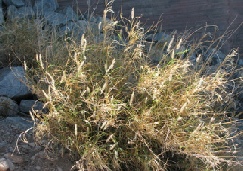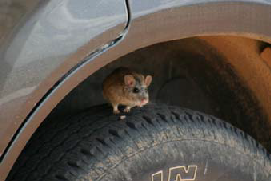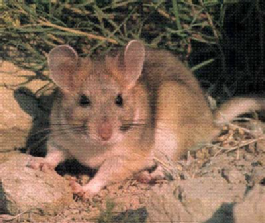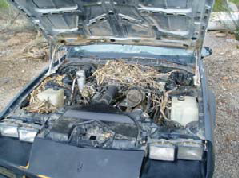Desert Life
Wildlife
One of the great joys of living in our little neighborhood is the opportunity to see wildlife virtually every day. From birds to reptiles, mammals to butterflies, the diversity is amazing. The original concept of the development was to live in harmony with the natural desert environment, retaining native vegetation and encouraging the presence of wildlife.
Naturally, conflicts can arise between human habitants and the animals that also call the desert home. People with small children or pets do not want rattlesnakes in the enclosed yard; javelinas and rabbits can be destructive to landscape vegetation; and scorpions can make their way into homes.
To enhance your enjoyment of our wildlife neighbors, education is the first step. Learn how to identify our local species and their behaviors. Learn which venomous reptiles are medically significant and which have an unearned bad reputation. Discover the role that each species plays in the scheme of life in the desert. Learn to plant vegetation that will attract the wildlife you want to encourage and to avoid that which will be immediately consumed by a hungry javelina.
A good source of information is the Arizona Game and Fish website:
Please remember that it is illegal to feed any wildlife except birds. Help keep wildlife wild.
DO NOT FEED!
Snakes
Snakes are especially active during the warm months of the year.
Non-venomous snakes in this area include GOPHER (sometimes called Bull), KING, COACHWHIP and smaller snakes like LONG-NOSED. These reptiles present no threat whatsoever to humans. A great site for snake identification is Reptiles of Arizona
The only snake you need to be concerned about is our venomous WESTERN DIAMONDBACK RATTLESNAKE, whose bite is medically very dangerous. Avoidance is your best policy. Rattlesnakes have no desire to bite you and would much prefer to quietly go their way, saving their venom for their food supply. Rattlesnakes are pit vipers, with a large, triangular-shaped head, black and white bands near the end of the tail, and a set of rattles at the very end.
Should you or your pet be a victim of a rattlesnake bite, get medical attention immediately! Do not hesitate, do not apply a tourniquet or try to suck out the venom.
Snakes are a very important component in the desert community, helping to keep the rodent population under control. A snake in your yard is most likely just passing through and will leave the area of its own accord. Stay aware at all times when outdoors, and as the herpetologists say, never put your hands, your feet or your butt somewhere you have not first looked!
NWFD Snake Removal Policy
If you call Northwest Fire Department for snake removal, please be aware that their policy has changed.
Dispatchers will ask a series of questions and if emergency criteria are not met, they will not dispatch a fire unit. The criteria for dispatch are:
In the house or garage
At a bus stop or playground
In an enclosed yard with no obvious means of egress
Callers are also encouraged to be tolerant of a snake that is not venomous by their description (black snake with white or yellow rings or black with no markings, for example). If the caller is persistent, they will dispatch a unit and the educational component is handled by the responding crew. The crew will still carry a box for the snake, but it will be used sparingly. Typically, the snake is placed outside the wall or in a nearby desert area and the crew will help the caller identify entry areas.
A crew will NOT respond for a snake in the road, a snake in your neighbor's yard or driveway, or a snake that has been run over!
Please remember that if you do not want snakes in an area where your children or pets play, it is your responsibility to make the area snake-proof. This is not a difficult task and can be accomplished with a roll of hardware cloth. Make sure the openings in the wire are too small to allow even a young snake to transgress. Snakes will use openings created by ground squirrels and other digging animals.
Bufflegrass
Buffelgrass is a non-native grass originally introduced for cattle forage and later for erosion control. "In Southern Arizona, the rapid spread of buffelgrass and the conversion of fire-resistant desert to flammable grassland rival urban growth and water as the region's most pressing environmental issues.
Buffelgrass has introduced a new wildfire risk into an ecosystem that is not fire-adapted. It grows in dense stands, crowds out native plants, and negatively impacts native wildlife species and their habitat.
Buffelgrass is considered a particularly serious threat to the saguaro cactus, the iconic plant of the Sonoran Desert Ecoregion, and is extremely detrimental to desert tortoise and mule deer habitat. Desert wildfires worsen the buffelgrass invasion because buffelgrass can quickly respond to fires, filling in the newly disturbed areas with seedlings. "
To learn more about buffelgrass and what you can do, go to Buffelgrass Information Center


Night Lighting
Astronomy is big business in Southern Arizona. Several thousand jobs and hundreds of millions of dollars in business depend directly and indirectly on astronomy. To help protect the industry and prevent the negative effects of night lighting, Pima County adopted a Dark Skies Initiative ordinance in 1972 and updated it in 2012. Tucson and Pima County take pride in their commitment to contain light pollution. But now we’re losing the battle to night lighting. The stars in the night sky are increasingly difficult to see from the urbanized area. In addition to the negative effects on astronomy, night lighting can also affect wildlife, waste energy, and impact human health. Not to mention that bright night lights can annoy your neighbors.
Dark skies are the law in Pima County. The purpose and intent of the code:
The purpose of this code is to preserve the relationship of the residents of the City of Tucson, Arizona, and Pima County, Arizona, to their unique desert environment through protection of access to the dark night sky. Intended outcomes include continuing support of astronomical activity and minimizing wasted energy while not compromising the safety, security, or well-being of persons engaged in outdoor nighttime activities. It is the intent of this code to control the obtrusive aspects of excessive and careless outdoor lighting usage while preserving, protecting, and enhancing the lawful nighttime use and enjoyment of any and all property. It is recognized that developed portions of properties may be required to be unlit, covered, or have reduced lighting levels in order to allow enough lumens in the lighted areas to achieve light levels in accordance with nationally recognized recommended practices.
To briefly summarize the law, homeowners should have no more than five night lights around the house.
To read more about dark skies, and what you can do to help, go the International Dark-Sky Association website.
Packrat Control






SOME TIPS FOR TARGETING DESERT PACKRATS WITHOUT HARMING OTHER SPECIES
Mary C. Stiner (July 2015)
One of the joys of living in the Oracle Foothills (OF) neighborhood is the richness of wildlife and vegetation. And course, there are all the great neighbors too!
We (Steve Kuhn and I) have lived in OF for more than 20 years and, over this time, have learned a lot about enjoying and co-existing with native species. Nearly all of us have struggled, however, with packrats (the desert packrat or woodrat), which may severely damage our homes, yards, and motor vehicles. Packrats can even impact our health because their nests are havens for kissing bugs, ticks, and fleas. Property damage from packrats can be very costly, and so naturally, many of us have felt the desperate need to get rid of them. A wide variety of methods are discussed on the web and elsewhere, but many of these are ineffective, and others do tremendous damage to other kinds of animals. In this short essay, I share my experiences in controlling packrats effectively and without harming other species in our environment. Like many people who might read this essay, my time for these kinds of activities is limited, and so I have stream-lined my methods over the years to those that (a) really work and (b) are doable over the long term. I hope that the information will be helpful to others—it has worked very well for me.
Some background packrat ecology and behavior
Packrats rely heavily on prickly pear cactus for food, along with the seeds, leaves, and fruits of other plants. The main predators of packrats in our area are coyotes, snakes, large owls, foxes, and ground-hunting hawks. I have watched coyotes raid packrat nests with great skill, and, as large predators, they can put away quite a few rats per month. Raptors (predatory birds) and snakes also do their part.
The rats are good climbers, and they are active mainly at night. They are also very industrious in their search for and construction of nesting sites. Each nest has a thick protective “shell” of sticks and spines and a soft core of finely shredded plant fibers. Normally, there is one rat per nest, though some rats may move among multiple nests. This means that removing one nest on your property is the equivalent of displacing approximately one rat, or one rat and her infants. In our area, packrats will reproduce in spring and may have another litter later in the year. The OF neighborhood has a high density of packrats relative to many other areas around Tucson.
Packrat removal
Because packrats are abundant in the Tucson area and not classified as a protected species, homeowners are free to remove them if they become pests. Be aware that packrats are clever and curious. They navigate by scent trails, and they have powerful homing skills.
One potential impediment to controlling them is the fact that they are rather cute and fuzzy. This becomes a problem when the neophyte trapper first peers into their sprung Have‐A‐Heart trap. What to do with the little prisoner? Well, my husband and I used to be among the ranks of folks who drove each live‐trapped rat several miles away and then set them free. It is nice to think that this is the kindest approach, but actually re‐location just passes the problem on to someone else and/or exposes to animal to horrific stresses, from which it often dies. In desperation the displaced animal may travel miles in order to return to the place where you trapped it, rather than die from exposure or conflict in the new place. So I have reached the conclusion that re‐locating rats is a feel‐good measure for people but not a kindness to the rats. Most biologists seem to agree.
On the other hand, I do understand that not everyone can stomach killing them. But for those of you who have reached the point of willingness to “do‐in” ratty pests, here is a method that will take care of the rats but not hurt other wildlife. In a word, we drown our live‐trapped rats in water and give the bodies to the garbage man.
Materials: One or more live traps; I strongly recommend a Have-a-Heart trap with a vertical sliding door (shown below), which is very efficient and lasts a long time (mine are 15 years old and still work great). Other animals rarely enter them, whereas rats find them almost irresistible. You will also need one sturdy, watertight container with a tight-fitting snap-on lid (very cheap at local hardware stores). I like a container that is large enough to accommodate two live traps. Make sure that the container is deep enough to fully submerge each trap. Place the plastic container on a level surface in a shady area, and fill it with water. The water will stay reasonably clean for quite some time if you keep the lid on. For bait, fruit slices work very well and don’t foul the trap (other people swear by peanut butter). That’s it!
Method: Place the bait toward the inside end of the trip pedal, so the rat must fully enter the trap and disturb the trigger. Place traps where you see fresh droppings, in runways leading to a nest, near walls, or where you have seen a rat moving about recently. Importantly, it is best set traps on the evening, and preferably on the night before garbage day (!).
Check your trap(s) in the early morning. Transport full traps to your water tank. Do not spend time looking at the rats or talking to them. Remove lid of the container and drop the traps into the water, making sure that they are fully submerged. Leave the area for about 15 minutes.
Return to the water bin and remove the trap by its handle. Open the trap door and drop the drowned rat into a plastic bag. Dispose of immediately. Doing this on garbage day eliminates the problem of a very smelly trash can.
The second part of the process.
A good routine is to do this once a month, even if you haven’t spotted a problem, or more frequently if you do see rats. This strategy continuously reduces the density of packrats around your home and suppresses nest building. Your problems will only get worse as nests become more common around your home.
There are other kinds of traps on the market that also allow you to kill packrats. I have used snap traps in the past, but these traps attract and kill other mammals and birds indiscriminately, so I stopped using them. Sticky traps may be okay, but they are not re‐usable and seem to guarantee a slow and miserable death. The nice thing about Have-a-Heart traps is that you can release non-targeted animals.
What to do about rat nests?
It may be a fool’s errand to try to remove all packrat nests from a large property, especially without also undertaking a total change of the vegetation. It is very worthwhile, however, to remove nests near your house or other buildings on your property, as these just attract new rats and concentrate kissing bugs, ticks, and other biting invertebrates.
Removing nests is no one’s idea of a good time, but it is not as horrible a job as it first appears. Of course, one option is to pay for their removal, and this may be well worth the money for some neighbors. Because this kind of service can be expensive over the long term, you may decide to remove the nest yourself. To do this, you need some sturdy garden tools, namely a shovel and a rake or hoe, and a bin or wheelbarrow (bags tend to be awkward because of all the thorns) to collect the material from the dismantled nest. Wear gloves and avoid handling the material directly because it will be full of sharp thorns and spines. Be sure to completely remove the nest, including the interior bedding area. Then rake the ground as a final cleaning of the area. If you are concerned about insects dispersing from the nest, you can finish by spraying the area with an insecticidal soap or thuricide bacteria mix (this is what the professionals do). Both sprays are very effective and ecologically friendly (I use them in my greenhouse, and they really work).
Long term control strategies
Many neighbors in OF have gradually changed some of the vegetation on their property as a way to discourage packrats. In fact, some of the plants on OF properties that are most attractive to packrats either are not native to our area (most agaves and prickly pear species) or they presently exist at much higher densities than is natural (this is especially so for the native prickly pear). Their dominance in local vegetation may be due to earlier landscaping choices, overgrazing in the deeper past, and other factors. The rats love to nest under prickly pear and untrimmed agaves, and these plants are also important sources of food and moisture for them. Major sections of our property, for example, were choked with prickly pear and monster agaves when we moved here, and we suffered major packrat problems for several years until we undertook a combination of regular trapping and a gradual removal of inappropriate plants. We leave some native prickly pear on our property as food for other wild animals, but we have taken most of these out. The barren ground left behind is quickly recolonized by much more attractive and manageable native shrubs that are also good for wildlife. What a difference these measures have made with respect to packrat control! We still have rats around the property, but now trapping is more than enough to keep them at bay.
Other important and possibly more obvious things one should do include sealing openings in buildings (pipes, vents, etc.) to keep the rats from invading. Also, because rats are disturbed by light as they move about at night, many neighbors use lights to discourage rats from entering under the hood of their motor vehicles. If you have a secluded spot near your house that seems to attract rats again and again, try installing a small solar light there. This has been very helpful in our case, such as behind a dense palm tree in a corner. Other methods of repelling rats, such as odorous chemicals or electric sound generators, do not work well, if at all, and are a great way to waste your money.
Why not just use poison?
Most or all poisons do collateral damage to wildlife. Following the directions on the package does not amount to safe practices because the animals and plants around us are bound into a complex, highly interconnected food chain. And then there are the hazards to pets and children to consider. Hardware and other supply stores regale us with a whole spectrum of poisons to use, but there is no truly safe way to use them if the chemicals persist in the environment (and most of them do). Rats that are poisoned with anti-coagulants, for example, may take 4-5 days to die a miserable death, and all the while they are available to hunting predators and to scavengers thereafter. Cached baiting (leaving multiple baits for future rats) raises the likelihood of down-the-line poisoning of other animals even higher. There really are better alternatives to poisoning rats and other pests.
Valley Fever
Taking steps to stay safe from Valley fever (also called coccidioidomycosis) is especially important in Arizona, where the fungus that causes the lung infection grows naturally in the soil.
Two-thirds of all Valley fever cases in the nation are reported in Arizona and the number of cases in the state has been noticeably increasing since 2016. In 2022, more than 9,500 Arizonans contracted Valley fever and 75 died from the disease.
The late fall and winter months, specifically from November to January, have historically had a higher number of cases. When wind, gardening, farming, yard work, or construction disturbs the soil the fungus lives in, the fungus can become airborne and enter people’s (and animals’) lungs, making them ill. Some people are particularly vulnerable to severe illness from Valley fever. Older adults, people with weakened immune systems, people with diabetes, and pregnant people should especially take measures to protect themselves.
A few ways you can protect yourself:
Avoid blowing dust.
Stay inside during a dust storm.
Wet the ground when doing any gardening or construction work.
Wear an N95 respirator if you expect to be exposed to blowing dust.
Wash your hands thoroughly after working in the soil.




